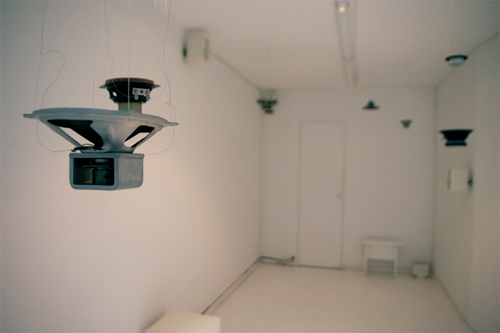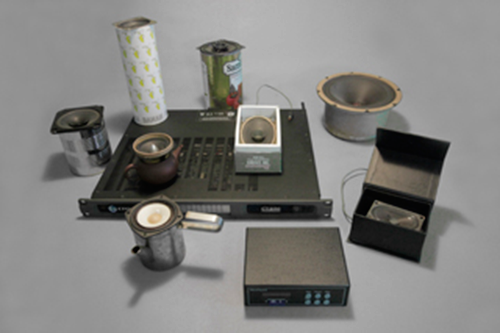FLOATING SOUND GALLERY
Vienna
Michael J. Schumacher

photo by aublur
Based in Brooklyn, Michael J. Schumacher has innovated in the area of spatialized sound and algorithmic composition since the 1980s, creating multi-channel, generative "Room Pieces" presented in galleries, museums, concert halls, public and private spaces. XI records has published a DVD set of five sound installations as computer applications, playable on up to eight speakers, which may be installed on a computer to create sound environments in the home. Schumacher’s composition “Grid”, a computer- generated score, has been in exhibitions in New York, Barcelona and Houston, and was performed by Ne(x)tworks Ensemble. His building-wide installation at EMPAC, in Troy New York, ran 24/7 for one year. “Living Room Pieces” is a generative installation designed for home listening; in 2021 Schumacher made an edition of 10 for Raspberry Pi. “The Portable Multi-channel Sound System” is a complete immersive environment that fits in a suitcase, with which he has toured Europe and the United States.
His interest in the relationship of musical form and architecture led to the founding of Diapason Sound Art, a gallery devoted to the presentation of multi-channel sound installations, long-duration performances and intermedia artworks. The gallery's two high quality sound systems and its attention to the details of heightening aural perception made it an optimal space for creating and experiencing minimalist and process-based work. In its 15 years of existence Diapason presented over 300 artists at a time when sound art was emerging as a distinct practice in the United States.
Schumacher’s compositions have been presented at Roulette, Issue Project Room, The Kasser Theater, Artists Space, Ostrava Music Days, The Sound Art Museum in Rome, Transmediale in Berlin, the MCA Lyon, The Hermitage in St. Petersburg, Klangraum Krems, The Dream House, Skanu Mezs Festival, among many others.
His music has been published by XI Records, Sub Rosa, Entr’acte, Quecksilber and Sedimental.
Schumacher is the music director of the Liz Gerring Dance Company, with whom he has collaborated on a dozen full-evening length works over the past 20 years. He also performs regularly with choregrapher Sally Silvers.
He studied music composition with Stanley Applebaum, Bernhard Heiden, John Eaton and Vincent Persichetti and piano with Seymour Bernstein, John Ogdon and Shigeo Neriki, and has degrees from Indiana University and Juilliard. He also worked with La Monte Young, Giampaolo Bracali and Milton Babbit. He has collaborated with choreographers, poets, architects, musicians and filmmakers including Oren Ambarchi, Bruce Andrews, Charles Curtis, Ken Jacobs, Victoria Meyers, Donald Miller, Ursula Scherrer and Stephen Vitiello.
He has received awards and residencies from NYFA, Harvestworks, RPI, DAAD, New Music USA, NYSCA, EMS Stockholm, Q-O2 Brussels, EMPAC and others. He's an adjunct professor at NYU and has guest-lectured at Bard and RPI as well as having recently been the Varèse professor at Berlin's TU.
Stills (series, since 1990s)
Stills are a series of pieces begun in the late 1990s that had, as their original conceptual basis, the idea of an active, complex auditory scene presented as a static form in which change occurs mostly in the details. Presented in multichannel formats in open spaces, listeners were supposed to “analyse” the sound through active physical engagement and, in so doing, invent a particular temporal interaction with it. Essentially an outgrowth of my interest in drones, the procedure, in terms of compositional method, was reversed, with the details coming first, rather than as a result of a (relatively) simple process. As the series has evolved, I’ve become more interested in exploring the implications of the initially created soundscape, using it as the basis for a more varied, multi-sectioned structure, searching for areas of development in suggested pitches, rhythms and interactions within the original texture.
Room Pieces, series, since 1993

@ AVA Gallery, New York, 2011
The Room Pieces are modular, algorithmic, multi-channel compositions that explore various modes of listening. Room Pieces define points in space and coordinates these points by the juxtaposition of related sounds, weaving a spatial geometry, a continuously shifting grid of multi-point relations with the listener as axis. Recurring events create grids of remembered time as complements to the geometry of space. Autonomous sound elements combine to form clusters of disparate structures, shifting contexts and remembered places and moments. Personal memories clash with collective; cultural influences inform the reception of compositional decisions. Every element remains highly independent, articulating its unique path into the future, but tied at every moment to coincidental, unpredictable simultaneities.
Filters and Filtered
Variations, 2017

(c) ursula scherrer
this set of pieces applies the classical idea of variation to spatialization techniques. sounds – sonorities, motifs, phrases – are transformed through placement in a variety of sonorous spaces, which act somewhat like filters, emphasizing specific perceptual aspects. in contrast to the classical method there are no clearly stated “themes”, but rather a continual process of spatial redistribution.
two exemplars that informed my compositional process were webern’s variations op. 27 and the late, short prose works of beckett such as ping; the webern for its clarity of construction, its specific technique of variation and its referencing of past procedures to achieve new results; the beckett for the “aha” moment it inspired when its underlying structure became evident, revealing its radical take on point-of-view, a perceptual shift like re-interpreting a reversible figure.
“variations” began as performances on the “portable multi-channel sound system”, a complete 12 channel system that fits in a suitcase, with which i’ve been gigging for the past couple of years. performances on this system involve interacting with algorithmic processes that engender the basic structural aspects of the music including not only pitch, rhythm and timbre but also spatial parameters, which determine distribution among the 12 speakers, as well as eq settings, delay and reverb mix. recordings of a number of performances were edited and manipulated and ultimately reduced to 8 channels.
from the start, it was my intention to explore the possibilities of recreating the sense of immersion one experiences in multi-channel listening within a stereo field. therefore, the stereo versions of variations aren’t intended as reference tracks or substitutes for the “real thing”, but as fully realized statements in their own right, with perhaps a shift in emphasis from spatial characteristics to the act of filtering.
the set, 12 pieces in all, is available in three formats: stereo uncompressed files for download; stereo mp3s for streaming; 8 channel .wav files for playback, via the daw of ones choice, on an 8 channel sound system. additionally, contour editions is offering a complete system for 8 channel playback which includes the files on ssd card, a “waveplayer” device, amplifier and 8 custom speakers made with high quality drivers and improvised resonators. an example of this complete system is shown in the linked photos.
Michael J. Schumacher on Room Pieces @ Gogolfest, FSG pavilion (Kiev, 2010):
re:enact, 10’43” / 2015
Composed for a video by artist Ronald Amstutz. 4 channel surround. Having worked, over the years, with many dancers and choreographers, particularly Liz Gerring and Sally Silvers, I’ve had some experience putting sound to movement. Ron’s video was created using stop action photography, every frame is set up in a painstaking process by the artist himself without assistants. I always try to walk the thin line between working with and against the visuals, though in this case the with won out. You never know where you’ll find your sounds – a particularly important sound in this piece I discovered on an old cassette tape made on a “Portable-studio” 4 track, played in the wrong direction! Accidents happen, sometimes for the better.
